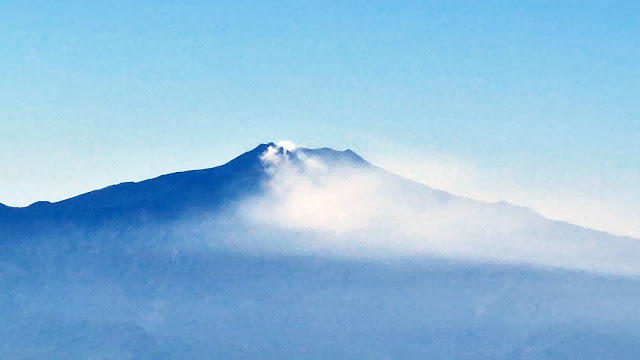I mentioned with the first Sicily post that there was a fascination with the geology of the island, the land dominated over time by volcanic activity. As we flew in to Catania a week ago we could see a smouldering Mount Etna and driving to the airport today Etna loomed over the city. My hope was that as we flew out I would get more views of Europe's most active volcano and it turned out I was in luck. We flew off to towards the east and then turned north, literally flying around Mount Etna.
Mount Etna, also called Mongibello, is one of the most
monitored volcanoes in the world. The spectacular eruptions and fiery lava
flows have always been of great interest to scientists and visitors from all
over the world.
Mount Etna’s first eruptions date back to about 570,000
years ago. The volcanic structure’s construction has been interrupted over the
centuries by numerous collapses. The most striking of these is the Valle del
Bove, on the eastern side, which formed 9200 years ago and contains much of the
volcano’s recent geological history.
Mount Etna is moving towards the Mediterranean Sea at an
average rate of 14 mm (0.55 in) per year, the massif sliding on an
unconsolidated layer above the older sloping terrain.
In Greek mythology, the deadly monster Typhon was
trapped under this mountain by Zeus, the god of the sky and thunder and
king of gods, and the forges of Hephaestus were said also to be
underneath it.
The last significant eruption of Etna was on the 29 May 2022 a sudden collapse of the Southeast Crater
created a fracture on its northern flank at an elevation of circa 2,800 m
(9,186 ft). A small lava flow emerged and headed in the direction of the Leone
Valley, just above the much larger Bove Valley. It continued for three days and
was accompanied by small and sporadic eruptions from two of the many vents at
the top of this crater.
We headed over Messina and then out across the Aeolian Islands, a archipelago of volcanic islands formed by the emergence of volcanoes, the first island we passed over was Vulcano.
The island is known for its volcanic activity and contains
several volcanic calderas, including one of the four active volcanoes in
Italy that are not submarine. The English word "volcano", and
its equivalent in several European languages, derives from the name of this
island, which derives from the Roman belief that the tiny island was the
chimney of Vulcan, the Roman god of fire. In November 2021, 150
people were evacuated from the island's harbour area due to increased volcanic
activity and gases; an amber alert had been issued in October 2021 after
several significant changes in the volcano's parameters.
Next to Vulcano is Lipari, and again you could clearly see a caldera, although this volcano is not considered active.
The other island within the archipelago that is an active volcano is Stromboli, but unfortunately we didn't pass close enough for me to photograph.
The end of our Sicily trip and we headed north west away from the warmth and sun of Sicily to the cold and dull UK.





No comments:
Post a Comment